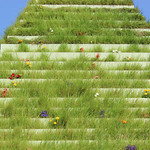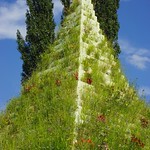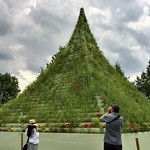The Living Pyramid- Social Ecology



Introduction: For my portfolio, I have chosen a structure created by Agnes Denes called the “Living Pyramid ” to illustrate social class evolution in the meaning of art. The “Living Pyramid” was created to convey human dramatization, our deepest desires against incredible chances. The pyramid re-established itself as development does to society. The Pyramid was displayed in Socrates Park located in Queens, New York and celebrated for the ability to encourage audiences to think about history and ecology on social rankings.
Theme: There are many themes that surround the Living Pyramid, but Agnes Denes uses two important themes to reach her audience. The first theme is ecology, Denes recreates the structure of a Pyramid using grass and flowers to represent the living and growing change in society to resemble the effects of evolution on humans. The second theme that is used is the social hierarchy, Denes uses multiple layers of living flowers and grass to represent how social ranking is always changing and never permanent. She expresses this by using living nature products that have a short life span to get her message across that everything is beautifully temporary. The Living Pyramid expresses social and environmental issues.
Analysis: I chose three images in different angles to represent the Living Pyramid. The first image was a front angle to show the materials used to make the pyramid. The second image I chose was a side view to show the height of the pyramid and how it was structuralized to display social ranking. The third and final picture was to show how the visitors of the park interacted with the pyramid. The Living Pyramid wasn’t created for the public enjoyment, the purpose was greater than a beautiful structure. Agnes Denes, amazing ecological structures correlate with her continuous investigation and development of pyramid structures – a structure that has been fundamental to the craftsman’s training all through her long and recognized profession. Denes has utilized the pyramid both basically and theoretically to look at natural needs and social ranking for fifty years. The Pyramid was made in organic form so it could be one with the living. Denes envisioned a utopian fantasy that would provide philosophical entertainment for visitors to the park. The Living Pyramid was made with significant help from the David Rockefeller Fund to celebrate the organizer David Rockefeller on the event of his 100th birthday celebration.
Application: Denes is chivalrous, having endured a misogynist workmanship world with sheer coarseness and knowledge. She has created a striking assemblage of work and thought. The Living Pyramid exists as a blooming landmark to Denes and her perplexing investigations. It’s an image of her innovative fruitfulness and life power. The living pyramid was a beautiful structure created to represent environment and social order issues. Agnes Denes developed a unique method of living nature to produce her message of change and temporal status in ecology and evolution. Denes encapsulated the use of nature to benefit society and the environment.

